
Apples - Spenser Seedless
Very curious apple variety described as 'parthenocarpic', 'apetalous' and other strange words ... it's a type which does not need to be pollinated, so needs no bees to develop fruit. The flowers are unusual; if you look at the pictures below (click on them to find the detail) you'll see that there are no petals to the flowers (hence 'apetalous') and there are no stamens (the parts which in normal apples produce the pollen).
FRUIT QUALITY
My first crop 2011; ripe on 15 Oct, about the same ripening time as May Queen and a little later than Ribston.
The fruit is entirely green; white-cream flesh. There are no seeds so the core seems very small (see pictures below). Flesh sweet and pleasant, not aromatic, not very acidic, dense, crisp, crunchy, slightly dry. It would probably store well. Its flesh is typical of a 'phase 3' (late storing) apple.
Here is a short article from a newspaper of 100 years ago telling us a bit more about the fruit ...
- THE SPENSER SEEDLESS APPLE.
A bulletin of the Wisconsin Horticultural Society publishes some views of horticulturalists as to the value of the Spencer seedless apple. In general, it appears that, while the apple is usually seedless, "an occasional seed being found near the calyx, and sometimes just under the skin," it is by no means coreless, and is inclined to be wormy.
The horticulturists generally appeared to speak disparagingly of the apple. They seem to have lost sight of one of the chief points of value about the apple — its possible ability to starve the codlin moth out of existence. The codlin moth in the opinion of some authorities, could not continue to reproduce its species without its natural food— the seeds of pippin fruit. If from the present usually seedless apple other seedless sorts could be produced of better commercial qualities, the codlin moth might become a thing of the past. The woolly aphis, formerly a pest that wrought much havoc in orchards, is now quite third-rate in the damage-it does, thanks to the use of blight-proof varieties as stocks.
(from "Poverty Bay Herald", NZ, 21 Mar 1908. see NZ archive .)
Joan Morgan's book gives the following information: the National Fruit Collection received the cultivar from the Long Ashton Research Station, Bristol, 1970; the apples are very large, open eye, tree rarely sets seed (no pips), poor flavour.
I don't agree with her assessment; flavour was fine.
UPDATE, ND Mar 2012
The crop of Spenser Seedless has kept in excellent condition until mid-March, cellar storage. I was surprised at the flavour; nearly as good as (and a better storer than) Wyken Pippin, though not quite as sweet. Most of the fruit had no core or seeds, but one had a core and contained 4 seeds so presumably the tree had self-pollinated; the blossom, which had no petals, is unlikely to have attracted any bees. Comments anyone?
LR .... if the seeds were set without cross-pollination the pips, if fertile, will produce clones; identical to the parent.
DV .... probably cross-pollinated and therefore will not breed true.
My comments [added Sept 2012] - the one seedling which survived has red leaves, quite different to the parent. It looks like it's cross-pollinated with a redfleshed apple (Almata was growing next to it).
Pictures (click on small images for detail):
Blossom
Thanks to Julie Drake for the first picture, which is far better than the other two (which I took). The structure of the flower can be seen clearly.
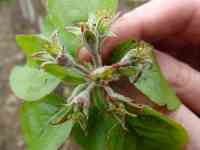 ....
....
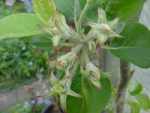 ....
....
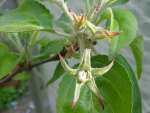 ....
....
Fruit 2011
 ..
..
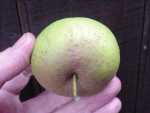 ..
..
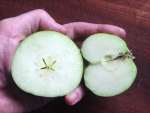 ..
..
Fruit 2016
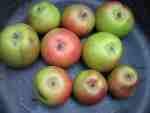 ..
..
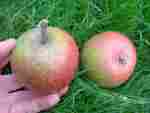 ..
..
ANOTHER NEWSPAPER ARTICLE, 1908
New Variety of Apple: Coreless, Seedless and Wormless
By A. Frederick Collins, Los Angeles Herald.
Volume 32, Number 169, 19 March 1905.
(Summarised by ND)
The seedless apple is a new discovery and will do for the apple what 'seedless' has done for the orange. In this apple there is no core, so a larger fraction of the fruit is edible.
It comes from Colorado, from the Grand Junction fruit district. There, John F. Spencer began experimenting ten or twelve years ago. He believed that it would be possible to develop the occasional "freak" seedless apple into a stable variety. He persevered, and eventually produced five trees which were almost seedless, though the fruit was not of commercial standard.
From these five trees he began budding and grafting to see the variety was stable, and to improve the quality of the fruit. He now has trees which are four, six aod eight years old, and they all bear seedless apples of a good color and fine quality. Occasionally an apple is found with a seed in it, usually far removed from where the core should be. The seed is produced by the pollen from the common apple trees being carried to the seedless trees either by bees or by the wind, but there is no blossom at any time visible at any time on these trees. There is a green bud similar to that on other apple trees, but when it opens there are no petals. There are stamens and stigmas and a negligible amount of pollen.
These seedless apples grow as large as the ordinary winter apple and contain as much juice. They mature later than other apples grown in Colorado. The flesh Is very firm and hard and they are extraordinarily long keepers. The apples are red when fully matured and have large strawberry or yellow dots. The trees have a hard, smooth bark and stand cold weather better than most of the other apple trees found in the area, and they are prolifoc bearers.
For the hotel and restaurant trade, as well as for the family eating and cooking, the fact that there are no seeds or seed pockets is a great convenience.
In the green apples, from the time they first appear an the trees until they are half or two-thirds grown, there are traces of a seed pocket, but by the time the apples reach maturity it becomes absorbed into the flesh of the apple.
The present supply of seedless, coreless and wormless apples numbers about 3000 trees and from these it is anticipated that 75,000 more will be ready for the market by the early autumn. Next year it is the ambition of the growers to have a quarter of a million nursery trees, from which the world will be supplied.
Mr. Spencer is not the first person to produce a seedless apple, but prior to his work there never has been a seedless apple of the slightest commercial value.
Note from ND, Apr 2015
... seedless apples never became commercially significant. Apart from specialist collectors, few people have heard of them.
ORCAS: SEEDLESS PEAR
On a similar subject, I was contacted by Dan Vorhis (from WA, USA) in 2011, who sent an interesting photograph and notes about a pear which he grows:
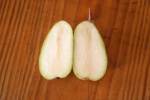 ..
..
"The Orcas pear is believed to have originated on one of the islands in the Pacific NW, USA. It is similar in texture and flavour to a Bartlett but very resistant to pear scab; ready in the fall. It can get quite large and for me is productive every year.
Almost all of the fruit is formed in the normal way and has seeds. However there are sometimes a few parthenocarpic fruit (as pictured). These result from occasional late (summer) flowers which do not get pollinated (see picture below). " - DV.
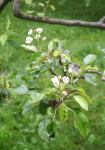 ..
..
See also the page for the seedless apple Wellington Bloomless .
There are other seedless apples, e.g. the Ukrainian varieties Chudachka (Eccentric) and Matryoshka.
compiled by Nigel Deacon / Diversity website